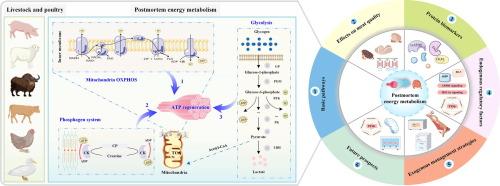死后能量代谢与肉质发育:基本途径、内源性调控因子和外源性管理策略的研究进展
IF 13
1区 综合性期刊
Q1 MULTIDISCIPLINARY SCIENCES
引用次数: 0
摘要
在肌肉转化为肉的过程中涉及一系列复杂的生化过程,其中死后的能量代谢有助于三磷酸腺苷的再生,这是最重要的。因此,及时和全面地了解死后能量代谢对于开发高质量的鲜肉至关重要。综述了死后能量代谢的三种基本途径及其对肉质发育的影响,重点介绍了线粒体有氧代谢。此外,还全面综述了调控死后能量代谢的内源因素及其机制和外源策略。死后线粒体,尤其是牲畜的线粒体,保持代谢活性并表现出氧气消耗,这进一步介导了肌肉ph的变化。腺苷单磷酸活化蛋白激酶和缺氧诱导因子-1α作为能量控制中心,对死后糖酵解的激活起着重要作用。一些蛋白质翻译后修饰(如s -亚硝基化和乳酸化)也通过改变代谢酶的结构和功能对死后能量代谢发挥重要的调节作用。外源性技术,如电刺激和先进的冷却可以通过优化能量代谢过程来改善肉的品质,而新兴技术,如超声波,则有希望。这项工作整合了现有知识,确定了研究空白,并提出了物种特异性死后能量代谢的科学展望本文章由计算机程序翻译,如有差异,请以英文原文为准。

Postmortem energy metabolism and meat quality development: Advances in basic pathways, endogenous regulatory factors, and exogenous management strategies
Background
A complex series of biochemical processes is involved during the transformation of muscle into meat, among which postmortem energy metabolism that contributes to adenosine triphosphate regeneration remains paramount. Thus, a timely and thorough overview of postmortem energy metabolism is essential for developing high-quality fresh meat.Aim of review
The present work reviewed three basic pathways of postmortem energy metabolism and their impacts on meat quality development with special attention to mitochondria aerobic metabolism. In addition, endogenous factors and their mechanisms as well as exogenous strategies for regulating postmortem energy metabolism were also comprehensively summarized.Key scientific concepts of review
Postmortem mitochondria, especially from livestock, remain metabolically active and exhibit oxygen consumption, which further mediates changes in muscle pH. Adenosine monophosphate-activated protein kinase and hypoxia inducible factor-1α, as energy-controlling hubs, contribute notably to the activation of postmortem glycolysis. Several protein posttranslational modifications (e.g., S-nitrosylation and lactylation) also show crucial regulatory roles for postmortem energy metabolism by altering the structure and function of metabolic enzymes. Exogenous techniques like electrical stimulation and advanced chilling can improve meat quality by optimizing energy metabolism process, while emerging technologies such as ultrasound hold promise. This work integrated existing knowledge, identified research gaps, and proposed a scientific outlook on species-specific postmortem energy metabolism求助全文
通过发布文献求助,成功后即可免费获取论文全文。
去求助
来源期刊

Journal of Advanced Research
Multidisciplinary-Multidisciplinary
CiteScore
21.60
自引率
0.90%
发文量
280
审稿时长
12 weeks
期刊介绍:
Journal of Advanced Research (J. Adv. Res.) is an applied/natural sciences, peer-reviewed journal that focuses on interdisciplinary research. The journal aims to contribute to applied research and knowledge worldwide through the publication of original and high-quality research articles in the fields of Medicine, Pharmaceutical Sciences, Dentistry, Physical Therapy, Veterinary Medicine, and Basic and Biological Sciences.
The following abstracting and indexing services cover the Journal of Advanced Research: PubMed/Medline, Essential Science Indicators, Web of Science, Scopus, PubMed Central, PubMed, Science Citation Index Expanded, Directory of Open Access Journals (DOAJ), and INSPEC.
 求助内容:
求助内容: 应助结果提醒方式:
应助结果提醒方式:


